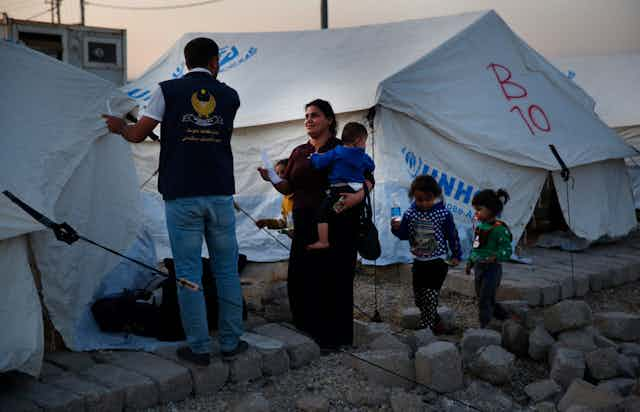Children’s summer reading may take on new meaning for parents this year. In the spring, after coronavirus school closures, some libraries reported increases to digital borrowing in children’s materials or new demands for library cards to serve children.
The COVID-19 pandemic provides parents with an opportunity to select books that address issues confronting children around the world and to engage children in discussions about children’s lives. In our efforts to protect children from political strife in the world, adults may forget that children are listening and watching. But children see and hear everything going on around them.
While adults worry about the future, their livelihood and survival, children’s feelings of fear, responsibility can go unheard.
Displaced children
UNICEF reports that there are nearly 50 million displaced or forcibly moved children in the world. Their dire and precarious circumstances are exacerbated by the effects of COVID-19. In 2019, Canada welcomed 28,000 displaced people. In 2012, more than 6,000 refugees who were permanent residents in Canada were under the age of 15. Some children seeking asylum in Canada arrive unaccompanied by adults.
Trauma specialist Alexandra Chen finds that reading programs, done well with children in refugee camps, can restore space for education and foster healthy relationships. NGOs like Millie’s Bookshelf recognize the vital importance of children having access to literature during times of crisis.

Reading and discussing literature
As my research has explored, reading and discussing literature about lives unfamiliar to our own deepens readers’ understanding of the world. In Literacy of the Other: Renarrating Humanity, I argued that some children’s literature that responds to their questions about the world renews a sense of purpose and meaning. Children’s literature can speak to children’s inner feelings, dreams and ideas. When I was an elementary teacher, I used children’s literature to offer displaced and upended children encouragement to share their experiences of historical and social crisis.
Now I use children’s literature with people who are studying to become teachers or teachers pursuing further education. I share my research on the role of reading in supporting a child’s capacity to learn from and relate to others, and initiate healthy growth into adulthood.
The following is a small selection of storybooks for all ages that address the situations of displaced children. These engaging literary works will appeal to both children who have experienced displacement and those who have not.
‘Marwan’s Journey’
Written by Patricia de Arias, illustrated by Laura Borràs.

Told from a small child’s point of view, Marwan’s Journey beautifully images the fear, uncertainty and sense of adventure a child can hold when unthinkable circumstances befall a family. With de Arias’s sparse narration, Borràs’s vivid illustrations document the family’s trek across the desert of an unnamed country in search of safe haven.
Through the story, Marwan brings children into his memories and attests to the loss of his homeland. Tired and weary, Marwan’s mother implores him to “keep walking” across the hot and dusty desert. Finally, the family reaches the line where the “sand meets the sea.” Hope is here, where Marwan dreams of planting a garden and renewing his self, life and dreams.
‘Stepping Stones’
Written by Margriet Ruurs, illustrated by Nizar Ali Badr and translated into Arabic by Falah Raheem.

Syrian artist Nizar Ali Badr’s stone figures inspired this story. With the artist’s images as illustrations, Canadian children’s writer Margriet Ruurs created a lyrical picture book, Stepping Stones.
This visually compelling story, first published in a dual-language English and Arabic edition, follows the journey of Rama as she and her family flee war-torn Syria in search of safe haven. The story has also been translated into Portuguese, Vietnamese, Persian, Japanese, Dutch, German, Turkish, Portuguese, Korean and Italian.
Badr’s stunning stone images bring Rama’s story to life. The work also reflects how adults’ creative collaboration can provide infinite possibilities for children struggling to make sense of their worlds.
‘Story Boat’
Written by Kyo Maclear, illustrated by Rashin Kheiriyeh.

Story Boat carries the lives of a family as they make the journey from their former home to wherever and whatever the world has in store for them. Written in rich and lilting prose, the story gently rides the waves of uncertainty a child can feel in a complex world.
Illustrator Rashin Kheiriyeh’s recognition of childhood displacement generates the soft and blurry illustrations that meld memories in the telling of the tale. Of her wondrous portrayal of communal journey, Canadian author Kyo Maclear writes:
“We think of refugees as people who wait a lot and suffer. But I wanted to portray a story where refugees also imagine, and dream, and run towards life.”
Telling truths
Renowned children’s writer Maurice Sendak says that exemplary children’s literature tells hard truths to children in language and images they can grasp. Reading in ordinary times, as well as times of crisis, plays a key role in addressing children’s growing understanding of their place in their families, communities and world.
One cannot underestimate the power and importance of parents reading aloud for and with children, in many languages, to facilitate rich and informed conversations with them.
Reading then becomes more than a school activity. Reading is a worldly activity, one that brings renewed meaning and significance to children and their lives in relation to others.

